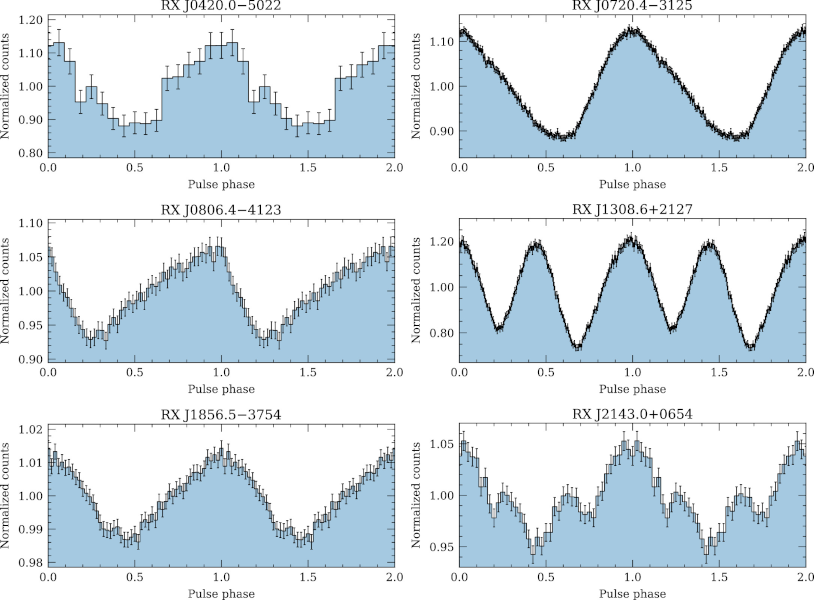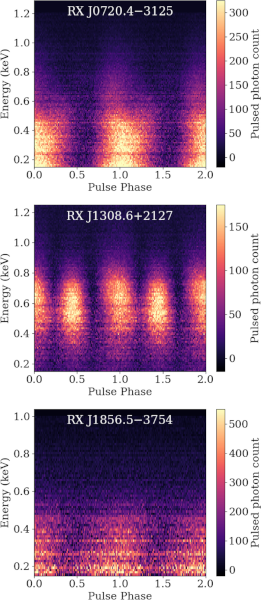NICER / ISS Science Nugget
for July 4, 2024
Magnificent neutron stars
In the 1990s, the European ROSAT X-ray observatory discovered seven relatively bright X-ray emitters with spectra corresponding to the thermal glow of matter at million-degree-Kelvin temperatures. Further investigation revealed that these objects, nicknamed The Magnificent Seven, are nearby neutron stars with mutually similar properties but distinct from the more than 2,000 other neutron stars known; they appear to represent a sub-population now simply called "X-ray-bright isolated neutron stars" (XINS). Six of the seven show regular modulation of their X-ray emission with periods between 3 and 11 seconds, clearly associated with the stars' rotation rates. They possess strong estimated surface magnetic fields (10^13 Gauss) and are approximately 1 million years old. But certain peculiarities of their observed properties defy straightforward explanations. For instance, the X-ray luminosities of XINS are too large to be explained solely by passive cooling - the shedding of residual heat from the fiery birth of the neutron star in a supernova explosion. XINS also exceed their "spin-down luminosities", the kinetic energy lost as the star's rotation slows down gradually over time, unlike rotation-powered pulsars. This implies that the observed surface thermal radiation does not draw from the rotational energy reservoir of the star but requires an additional source, most probably internal heating due to magnetic field decay, which may explain the apparently strong surface magnetic fields of the Magnificent Seven.
The observed X-ray pulsations imply non-uniform temperature across the stellar surface - essentially, "hot spots." At present, a self-consistent model of the broadband emissions of the Magnificent Seven is lacking, their surface compositions and thermal and magnetic maps are unconstrained. Mapping surface X-ray emission as a function of time and energy with realistic physical models has the potential to reveal the processes responsible for the peculiar properties of XINS, including the nature of internal heat sources. A crucial prerequisite is the availability of reliable long-term pulse timing solutions to maintain accurate knowledge of the rotation state of each star over time.
In a recently published peer-reviewed paper in The Astrophysical Journal - the first in a series of three - S. Bogdanov (Columbia U.) and W. C. G. Ho (Haverford College) combined NICER data, obtained since the start of the mission, with a trove of archival data (from NASA's Chandra X-ray Observatory and the European XMM-Newton tele"ope) collected over the past two decades, to improve upon existing spin models of the six pulsed XINS, extending them by as much as an additional decade. Through their in-depth analysis, Bogdanov & Ho measured the slowing-down of the spin rate of one Magnificent pulsar for the first time, and discovered unambiguous changes over time in the pulses of another. The high-quality X-ray pulse profiles produced with their updated timing solutions exhibit diverse and complex morphologies, as well as striking energy dependence. These behaviors cannot be readily explained by blackbody-like isotropic emission and simple hot-spot configurations, hinting at the presence of complex multi-temperature surface heat distributions and highly anisotropic radiation patterns, such as may arise from a strongly magnetized stellar atmosphere through which the surface radiation must pass before reaching us. Follow-up investigations that make use of these results to gain further insight into the peculiar properties of the Magnificent Seven are underway.


Left: The X-ray brightness profiles of the six pulsars among the Magnificent Seven that are known to pulse periodically, using data collected over up to 22 years with three telescopes (most recently, NICER). In each panel, the same data are plotted twice to clarify continuity across cycles. Different pulse shapes - e.g., one vs. two or more peaks per cycle - reflect the different hot-spot configurations on the surfaces of the various sources. Data quality depends on overall source brightness and the total exposure acquired. (Credit: Bogdanov & Ho 2024)
Right: Phase-energy "portraits" of three of the Magnificent Seven pulsars, demonstrating how the pulsed emission depends on X-ray photon energy. Color represents the number of photons detected above a constant background within each bin defined by rotational phase and photon energy boundaries in the two-dimensional map. Energy dependence seen as subtle shifts in phase (e.g., bottom panel) or apparent bifurcations (top panel) reveal temperature differences in surface hot spots. Horizontal stripes are instrument features that are accounted for in later analysis. (Credit: Bogdanov & Ho 2024)
<< Previous
Main Index
Next >>